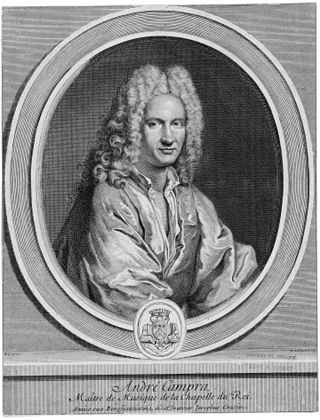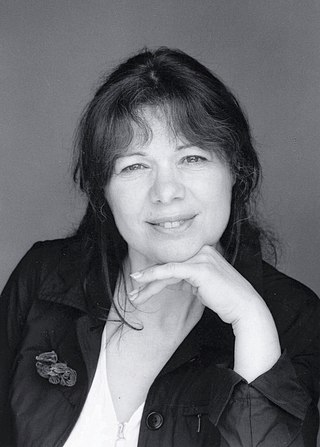
André Campra was a French composer and conductor of the Baroque era. The leading French opera composer in the period between Jean-Baptiste Lully and Jean-Philippe Rameau, Campra wrote several tragédies en musique and opéra-ballets that were extremely well received. He also wrote three books of cantatas as well as religious music, including a requiem.

Marc-Antoine Charpentier was a French Baroque composer during the reign of Louis XIV. One of his most famous works is the main theme from the prelude of his Te Deum, Marche en rondeau. This theme is still used today as a fanfare during television broadcasts of the Eurovision Network and the European Broadcasting Union.

Henri Desmarets was a French composer of the Baroque period primarily known for his stage works, although he also composed sacred music as well as secular cantatas, songs and instrumental works.

Élisabeth Claude Jacquet de La Guerre was a French musician, harpsichordist and composer.

Les Arts Florissants is a Baroque musical ensemble in residence at the Théâtre de Caen in Caen, France. The organization was founded by conductor William Christie in 1979. The ensemble derives its name from the 1685 opera Les Arts florissants by Marc-Antoine Charpentier. The organization consists of a chamber orchestra of period instruments and a small vocal ensemble. Current notable members include soprano Danielle de Niese and tenor Paul Agnew, who has served as assistant conductor since 2007. Jonathan Cohen is also on the conducting staff; Christie remains the organization's Artistic Director.

Sébastien de Brossard, pronounced [se.bɑs.tjẽ də brɔ.saːr], was a French music theorist, composer and collector.

Marie de Lorraine was the daughter of Charles de Lorraine, Duke of Guise and Henriette Catherine de Joyeuse and the last member of the House of Guise, a branch of the House of Lorraine.
The chapelle royale was the musical establishment attached to the royal chapel of the French kings. The term may also be applied to the chapel buildings, the Chapelle royale de Versailles.
Henry Madin was a French composer at the Chapelle royale and music theorist.

The Église Saint-Paul-Saint-Louis is a church on rue Saint-Antoine in the Marais quarter of Paris. The present building was constructed from 1627 to 1641 by the Jesuit architects Étienne Martellange and François Derand, on the orders of Louis XIII of France. It was the first church in Paris to break away entirely from the Gothic style and to use the new Baroque style of the Jesuits, and it had an important influence on Parisian religious architecture. It gives its name to Place Saint-Paul and its nearest Metro station, Saint-Paul. Next door to the church is the Lycée Charlemagne, also founded by the Jesuits.
Philippe Courbois was a French Baroque composer. It is commonly stated that he was maître de musique of the Duchess of Maine, but Michele Cabrini convincingly refutes this claim in his edition of Courbois's cantatas. At least three of his masses were performed for the King of France at Versailles. Sometime before 1710, Courbois published a book of seven cantatas with texts by Louis Fuzelier, who would later write the libretto of Les Indes Galantes. It is these cantatas for which he is most famous today
Le Concert Spirituel is a French ensemble specialising in works of baroque music, played on period instruments. Founded by Hervé Niquet in 1987, it is named after the 18th-century concert series Concert Spirituel. The group performs internationally, playing mostly rarely performed sacred music and operas, and making recordings. Its focus is on French music played at the court of Versailles.
Jean Dun, also known as Jean Dun "père", was a French opera singer active at the Paris Opéra where he created many bass roles during the late 17th and early 18th centuries. He was also the bass soloist at the church of Saint-Paul-Saint-Louis in Paris during the time Charpentier was the Master of Music there. His voice is described in contemporary sources as basse-taille, which is closer in quality to that of a modern baritone.
Jean Boyer was a French viol player and composer, active in Paris during the first half of the 17th century.

Sylvie Mamy, born in Besançon, is a French writer and musicologist, Docteur d'État ès lettres, and research director at the CNRS.
François Porcile is a French film director, essayist, film historian and musicologist.
Antoine de Cousu [Du Cousu] was a French cleric, Kapellmeister, composer and theorist, active in Picardy in the first half of the 17th century.

Alexis Galpérine is a French classical violinist.
Henri Moreau was a Belgian composer and teacher born in Liège in what is now modern-day Belgium. He studied with Bartolomeo Lustrini and Antonio Aurisicchio and he is known to have taught André Ernest Modeste Grétry. Moreau composed religious works which were never printed but would have included Christmas carols popular at the time in Liège. Moreau wrote a number of instrumental works, for example 6 trios, which are known to have been written in Liège around 1777 but were subsequently lost.
Olivier Schneebeli is a French conductor and choirmaster, as well as music teacher, known for his work on Baroque music. He was named to the Legion of Honour in 2021.










